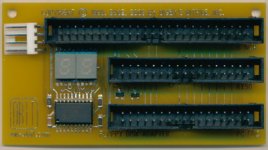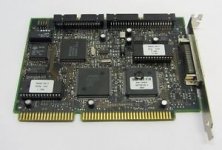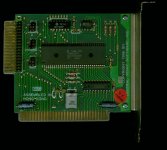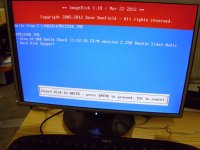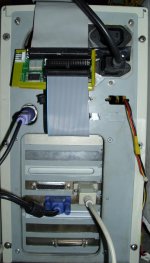Hans01
Experienced Member
Having always trouble with copying disks I built an ultimate copy machine.
It consists of an old MSDOS computer with an opti green motherboard
with an ISA bus and award bios, a 486-DX2-66 processor and a 720 and a
1.44 floppy drive.
It is very important to use the Adaptec 1542CP controller to connect the
floppies.
It is the only controller which can handle single and double density data.
It is not possible to connect a SCSI harddisk to the adaptec as
the award bios doesn't scan the memory blocs in the right way.
Any tric to solve this problem didn't help.
The only way is to use a multi I/O adapter to connect an IDE harddisk
I installed MSDOS 6.22 and later Windows 98SE too, to support some extra tools.
The adaptec controller is connected with a flatcable to the option board and
passes trough the board to the both floppys.
I brought this cable outside the computer and split the cable in two parts with
a 34 pin male and female connector.
In the BIOS I can swap the A: and B: drive in case of a
floppy boot with different type of floppy
If I connect the two parts together I can use both floppys.
If I open the connectors I can connect to one part of the cable to one or
two 5.25 drives or my new FDADAP adapter.
(This is realy a great tool to support painless 8" drives, a really must to
have device for Model II users)
With this machine I can Read, Write and Edit all Tandy 720, 1.44, 5.25 and 8"
SS and DS disks in Single and Double density.
I can backup all my disks to my harddisk now and rebuild them in a moment.
As software a use COPYIIPC, TELEDISK, IMD (Image) and many other tools.
It is a lot of work to build this machine but it is worth the costs and the time
a spent for it.
It consists of an old MSDOS computer with an opti green motherboard
with an ISA bus and award bios, a 486-DX2-66 processor and a 720 and a
1.44 floppy drive.
It is very important to use the Adaptec 1542CP controller to connect the
floppies.
It is the only controller which can handle single and double density data.
It is not possible to connect a SCSI harddisk to the adaptec as
the award bios doesn't scan the memory blocs in the right way.
Any tric to solve this problem didn't help.
The only way is to use a multi I/O adapter to connect an IDE harddisk
I installed MSDOS 6.22 and later Windows 98SE too, to support some extra tools.
The adaptec controller is connected with a flatcable to the option board and
passes trough the board to the both floppys.
I brought this cable outside the computer and split the cable in two parts with
a 34 pin male and female connector.
In the BIOS I can swap the A: and B: drive in case of a
floppy boot with different type of floppy
If I connect the two parts together I can use both floppys.
If I open the connectors I can connect to one part of the cable to one or
two 5.25 drives or my new FDADAP adapter.
(This is realy a great tool to support painless 8" drives, a really must to
have device for Model II users)
With this machine I can Read, Write and Edit all Tandy 720, 1.44, 5.25 and 8"
SS and DS disks in Single and Double density.
I can backup all my disks to my harddisk now and rebuild them in a moment.
As software a use COPYIIPC, TELEDISK, IMD (Image) and many other tools.
It is a lot of work to build this machine but it is worth the costs and the time
a spent for it.

